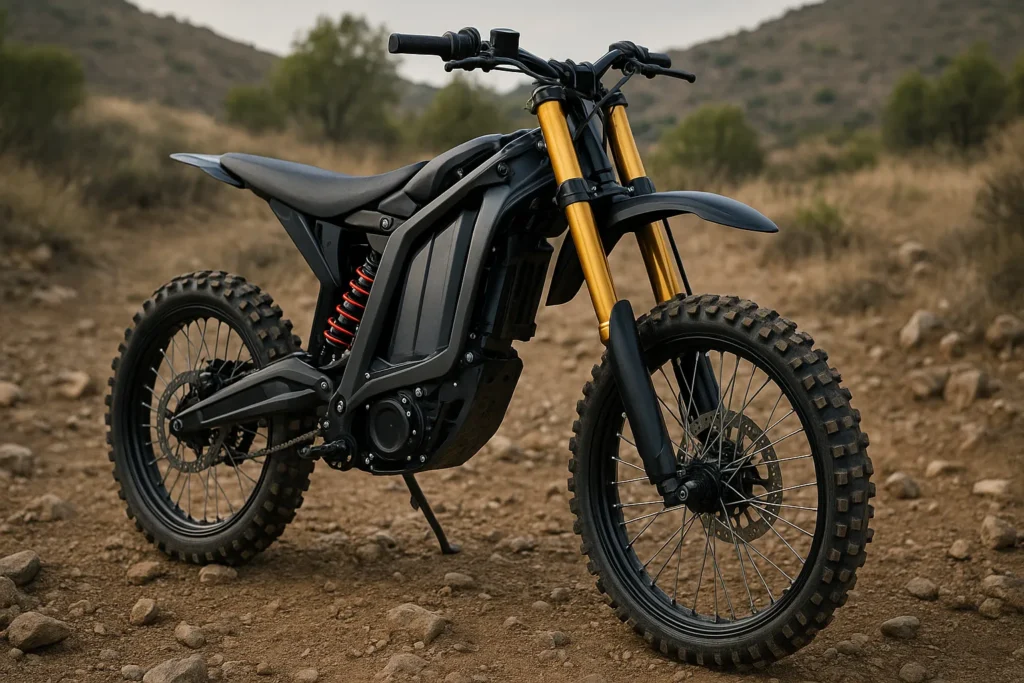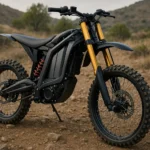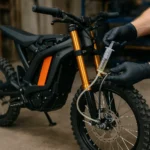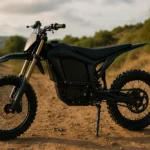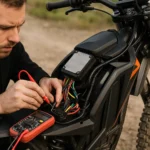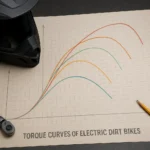Finding the best suspension setup for e-dirt bike is the first step toward transforming how your electric dirt bike handles every bump and curve. A well-tuned suspension doesn’t just make your ride smoother—it improves traction, control, and long-term durability. Riders who want better stability and comfort quickly realize that adjusting forks and shocks is as important as battery range or motor power ⚡.
Whether you’re tearing through rocky trails, carving sandy corners, or cruising through forest paths, the right adjustments make all the difference. Fine-tuning sag, compression, and rebound ensures your bike feels balanced and responsive under your weight. This balance is what separates a sketchy ride from an enjoyable session with total confidence 👊.
If you’re new to dialing in suspension, don’t worry—you’re in the right place. This guide breaks everything down in a simple way so that riders and parents can understand how to maximize performance. And if you’re curious about how speed connects with handling, check out our full breakdown of the fastest electric dirt bike.
By the end of this guide, you’ll see why chasing the best suspension setup for e-dirt bike is one of the smartest upgrades you can make. The right settings give you confidence, safety, and the thrill of riding in full control. So let’s dig in and unlock the secrets to finding the best suspension setup for e-dirt bike tailored just for you 🚀.
Key Takeaways
- How suspension tuning impacts handling and comfort.
- Step-by-step tips to adjust front forks and rear shocks.
- Mistakes riders make when setting sag and rebound.
- How terrain and rider weight affect stiffness vs. softness.
- Best practices for long-term suspension maintenance.
⚡ Here’s what this guide will teach you: Check the quick links below to jump to the section that matters most 👇
Understanding Suspension Basics
Getting the best suspension setup for e-dirt bike starts with knowing how the system actually works. Suspension isn’t just about comfort—it’s about keeping the tires glued to the ground for maximum traction and control. When the wheels stay connected, the bike handles better, brakes more effectively, and reacts predictably even on rough trails.
Front forks and rear shocks are the two main players. Forks take care of bumps at the front, while shocks stabilize the rear. Together, they absorb impacts, reduce vibration, and prevent fatigue during long rides. Think of suspension as the invisible shield that protects both the rider and the bike.
Key components include springs, dampers, preload adjusters, and rebound controls. Each of these elements works together to balance stiffness and softness. Springs carry the load, dampers manage energy release, and rebound ensures the bike doesn’t bounce uncontrollably after hitting obstacles.
A good suspension setup adapts to terrain. On rocky paths, you’ll need more compression to avoid bottoming out. In sandy or muddy conditions, softer settings give the wheels better grip. By understanding these fundamentals, riders can begin fine-tuning their bikes for performance, safety, and confidence on any trail.
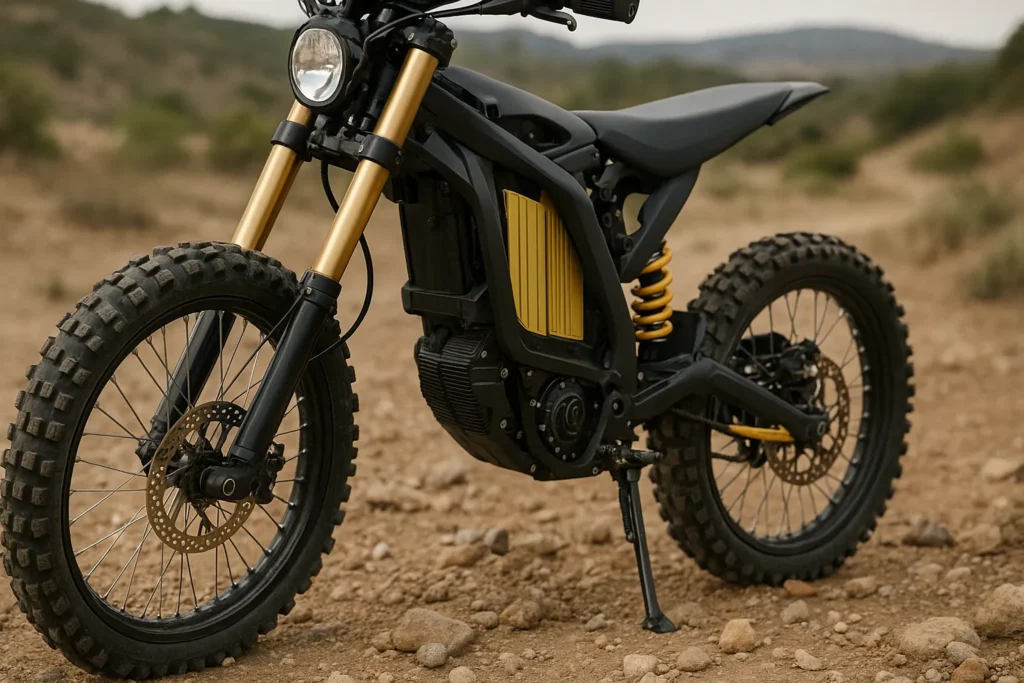
Setting Up Your Suspension the Right Way
Dialing in the best suspension setup for e-dirt bike doesn’t need to feel overwhelming. The process comes down to a few clear steps that anyone can follow, whether you’re a weekend rider or training for competitive off-road challenges.
The first step is measuring rider sag. This tells you how much the bike compresses under your body weight and gear. Too little sag makes the bike harsh and unstable, while too much sag causes it to sink and lose traction. Getting this measurement right is the foundation for everything else.
Next comes adjusting compression and rebound. Compression controls how quickly the suspension absorbs bumps, while rebound determines how fast it returns after an impact. A simple way to think about it: compression is how deep you sink, rebound is how fast you spring back.
Finally, match your settings to the terrain. Rocky trails demand firmer forks and shocks to avoid bottoming out, while softer adjustments work better in sandy or muddy paths to keep traction steady. Each tweak makes the ride smoother, safer, and way more enjoyable.
Top 5 Suspension Mistakes Riders Make
Even riders who chase the best suspension setup for e-dirt bike often fall into the same traps. These mistakes can make the bike harder to control, reduce comfort, and even cause unnecessary damage over time.
One of the biggest errors is setting sag without wearing full riding gear. Your weight changes once you add a helmet, boots, and protective clothing, which throws off your measurements. Another common problem is cranking rebound too tight, making the suspension feel lifeless and unresponsive.
Copying someone else’s suspension settings blindly is another pitfall. What works for a 200-pound aggressive rider won’t suit a lighter beginner cruising forest trails. Each bike and rider combo requires its own fine-tuning. Skipping regular maintenance is just as damaging—dust, mud, and worn-out oil seals all mess with performance.
If you want a deeper dive into how suspension upgrades really affect electric dirt bikes, check out this excellent resource on suspension upgrades for electric dirtbikes. It explains how different setups influence handling, stability, and long-term durability.
Avoiding these mistakes will keep your suspension working smoothly, helping you stay safe, ride longer, and get the most fun out of your bike every time you hit the trail.
Rider Weight and Suspension Balance
The best suspension setup for e-dirt bike is never one-size-fits-all. Your body weight plays a massive role in how the suspension behaves, and ignoring this factor can ruin the balance between comfort and control.
Heavier riders usually need stiffer springs to prevent bottoming out on jumps or rocky terrain. Without this extra stiffness, the bike sinks too deeply into its travel, making it unstable. On the flip side, lighter riders benefit from softer preload, which allows the wheels to stay connected with the ground and improves traction.
A good rule of thumb is to measure sag percentages and adjust preload accordingly. This ensures the front forks and rear shocks compress just enough under your riding weight. Matching these numbers to your frame helps the bike feel more predictable, whether you’re attacking technical trails or cruising smoother paths.
By respecting weight-specific adjustments, riders gain more confidence, better stability, and a smoother experience that protects both the bike and their bodies from unnecessary strain.
Suspension Setup for Different Riding Styles
Finding the best suspension setup for e-dirt bike depends a lot on how you actually ride. An aggressive rider blasting through jumps and rough tracks needs stiffer compression and quicker rebound to keep the bike stable at high speeds. On the other hand, casual trail riders usually prefer a softer setup that smooths out bumps and keeps the ride comfortable.
For beginners and younger riders, lighter preload and slower rebound give more confidence and control, preventing the bike from reacting too sharply. This makes learning easier and reduces fatigue during longer sessions.
If speed is your main goal, you’ll want to balance stiffness and responsiveness carefully. We explain how handling and velocity work together in our full guide to the fastest electric dirt bike.
By tailoring your suspension to your style, you create a bike that feels natural and predictable, helping you get the most out of every ride while staying safe.
Pro Tips for Long-Term Suspension Care
Keeping the best suspension setup for e-dirt bike performing at its peak isn’t just about dialing in the right numbers—it’s also about consistent care. Even the most perfectly tuned forks and shocks will lose performance if neglected over time.
One of the easiest habits to adopt is cleaning the dust seals after every ride, especially if you’ve been through mud or sand. Dirt build-up wears down seals and shortens the life of your suspension oil. Speaking of oil, checking levels and quality every 25 to 30 riding hours ensures smooth damping and prevents harsh bottoming out.
Inspecting bushings and seals regularly can save you from expensive repairs. Small leaks or cracks can quickly turn into major issues if ignored. Riders who take a few minutes for preventive checks often enjoy more consistent performance and fewer breakdowns.
Finally, don’t forget seasonal adjustments. Cold weather thickens suspension oil, while hot summer trails make it thinner. Matching your setup to the environment keeps handling predictable and your rides enjoyable year-round.
FAQs About Suspension Setup
How often should I check my suspension settings?
For most riders, checking every month is enough. If you switch between rocky terrain and smooth trails, it’s smart to review settings more often to keep balance and comfort.
Do electric dirt bikes need different suspension than gas bikes?
Not entirely, but e-dirt bikes are usually heavier. This means riders may benefit from stronger springs or stiffer damping to handle extra weight without losing control.
What’s the ideal sag for beginners?
Around 30% rear sag is a safe starting point. It balances stability with comfort, making the bike forgiving while still responsive.
Should I change suspension for racing?
Yes. A racing setup usually means firmer compression and faster rebound to keep stability at high speeds. It allows riders to push harder without the bike bouncing unpredictably.
Can suspension affect battery life?
Indirectly, yes. A poorly tuned suspension wastes energy because the tires lose traction and the motor works harder. With the best suspension setup for e-dirt bike, efficiency improves since the ride stays smooth and consistent.
Final Thoughts: Dial in Your Perfect Setup
Chasing the best suspension setup for e-dirt bike isn’t about copying numbers from someone else’s ride—it’s about personalizing adjustments to your own weight, style, and terrain. Every rider is different, and finding that sweet spot requires patience and experimentation.
Start with sag, then move on to compression and rebound. Make small changes and test on familiar trails so you can clearly feel the difference. Over time, your bike will respond exactly how you want it to, boosting both performance and confidence.
Remember that suspension is a living system—it needs care, maintenance, and occasional retuning as your skills improve or conditions change. Riders who commit to learning and fine-tuning discover that their electric dirt bike feels smoother, safer, and way more fun.
Join the Conversation
Now that you’ve seen how the best suspension setup for e-dirt bike can completely change the way you ride, it’s your turn to share. Every rider has their own style, and the community grows stronger when we exchange tips, mistakes, and successes.
Drop a comment below and let us know what settings worked best for you. Have you noticed a big difference when switching from soft to stiff compression? Or maybe you’ve learned how rebound adjustments improved your confidence on rough trails.
If you’re hungry for even more ways to boost your bike’s performance, check out our detailed breakdown of the fastest electric dirt bike.
And don’t forget—sharing this guide with your friends or fellow riders helps build knowledge across the entire e-dirt bike community. Together, we make the trails safer, faster, and way more fun.

Tyler Brooks is the storyteller behind most of the content at Electric Dirt Zone. With over 10 years of experience in digital media and a lifelong love for off-road riding, he blends technical insight from the team with engaging, down-to-earth writing. When he’s not turning dusty trail rides into blog posts, you’ll probably find him snapping pics before things get too wild.

